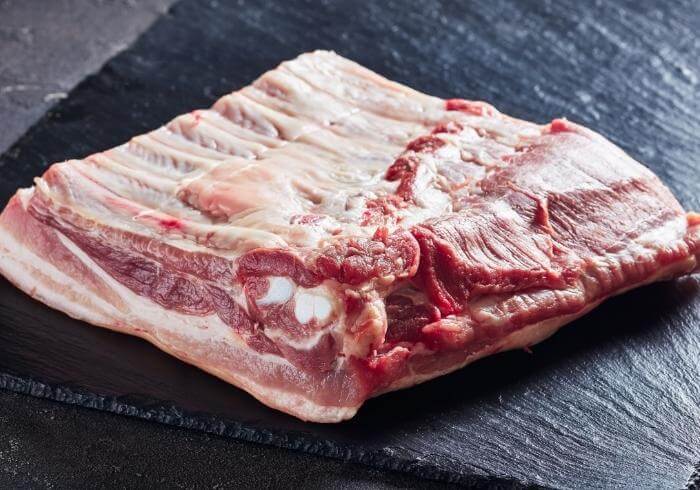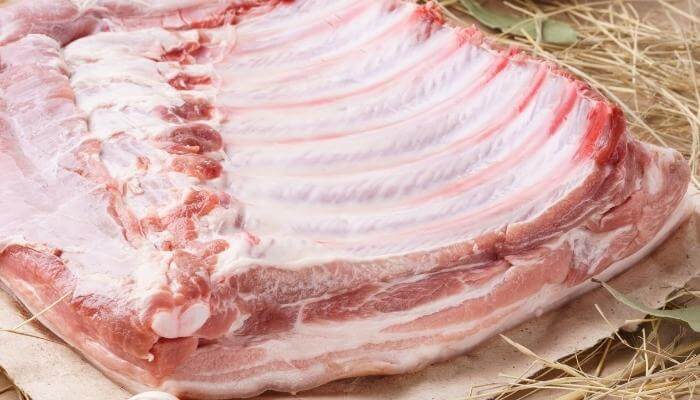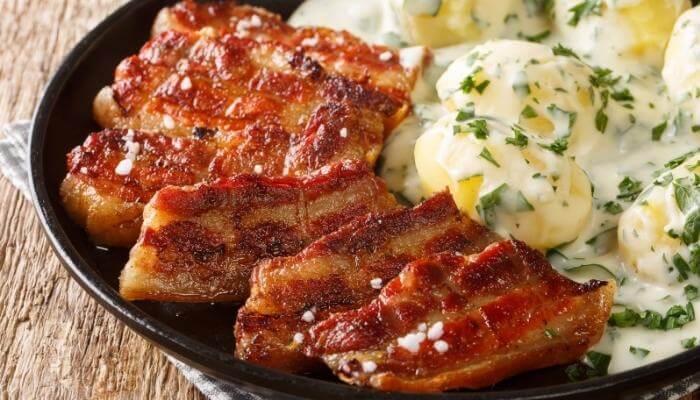In the greatest food non-fight of all times, we put pork belly against the suspiciously similar side pork.
In this article, we’ll explain about the difference between both the suspicious and the delicious, and give you tips on how to pick the best pork belly and how to prepare it.

Is Side Pork and Pork Belly the Same?
Let’s not beat around the butcher:
Side pork and pork belly are two names for the same cut.
No matter which your grocer prefers to scrawl on their display case label, the meaning, and the meat will be the same. These two might make one of the most confusing nickname pairs in the carnivore kingdom.
The reason behind much of the confusion lies in a misleading viral post from an early internet foodie forum.
The anonymous comment went to great and uninformed lengths to explain how side pork was different from pork belly and was soon sorted way too highly by the Google search algorithm.

Butcher tradition divides a hog into four main parts, which they call “primals.”
Pork side or belly is one of the four primals.
The other three are:
- The loin, which is actually the back
- The back leg, which is where ham comes from
- The shoulder, which is sometimes called “pork butt,” even though it’s nowhere near the rear end
You can see the meat industry may have a bit of a misnomer problem. Or perhaps it’s a feature.
If you take a closer look at pig anatomy and really squint your eyes, you can kind of see why some butchers call the belly “side pork.”
The front and back of most human torsos are wider than the sides, but pigs are the opposite. They’re generally wider when seen from the side than from head-on, so it makes more sense to talk about their sides instead of their front and back.
This side or belly primal starts on one side of the pig, wraps underneath it, and ends on the other side.
The butcher usually removes it in one piece, including the skin, the fat and muscle underneath, and the rack of ribs.

Once you peel off the ribs, the thick slab of meat, fat, and skin that’s left is actually the primary pig part used to make bacon if you cure, smoke, and slice it just right. But fresh off a pig, uncured and unprocessed, we call it side pork or pork belly.
How Much Does Pork Belly Cost?
The pork belly primal is a mid-priced cut of meat. If you compare it to other gourmet cuts like the loin or shoulder, it’s actually relatively cheap.
The ideal piece of pork belly depends on what you plan to do with it. We recommend telling your butcher your cooking plans so they can help you pick the perfect piece.
For example, if you want to make pork crackling, you’ll need a piece with a dry rind and a thick, juicy ribbon of fat underneath. If you plan on making bacon or a pork belly roast, it’s better to buy it unsliced. If you’re thinking of braising it, getting it pre-sliced will reduce your cooking time.
In general, a quality slab of pork belly should come with three distinct layers, each with its own distinct texture and color:
- A thin outer layer of skin
- A silky stream of fat under that
- Streaks of pink or red meat interwoven with fat at the bottom
Healthy meat should be pink or red, not grayish or browning. It should smell neutral and feel firm with no slime.
The fat should be soft yet firm and creamy white, not yellowish or gray. Discoloration of the fat means the pork belly is beginning to age.
The ideal ratio of fat to meat should be around 50:50. If there are plenty of white streaks of fat striping the layer of muscle, it will taste extra juicy.
A nice even distribution of fat and meat will make portioning it easier and avoid someone ending up with a plate full of fat and hardly any meat.
What Can You Make With Pork Belly?

For better or worse, pork belly’s fat content is through the roof. Downsides aside, this lends an extra dimension of flavor to the meat and an extra layer of versatility to the cut.
One of the most popular things to make with pork belly is bacon or pancetta, an Italian form of unsmoked bacon. If you have a lot of time and a cool, dry place to cure it, homemade bacon can be one of life’s tastiest simple pleasures.
If you want it in your mouth a bit sooner, slow-roasting it in the oven will simultaneously melt the fat, crisp the skin, and soften the meat. This creates a fascinating contrast of textures that will keep your tongue in awe.
Unlike pork chops and other leaner cuts, pork belly doesn’t respond well to high heat. Belly muscle has lots of connective tissue, which only breaks down after extended exposure to low heat. Low heat is also the best way to render the layer of fat just beneath the rind.
Whatever dish you decide to make with it, cook it slowly with plenty of moisture over a mellow flame to create a perfect storm of flavor and texture.
If you don’t want a mouthful of rubbery fat and chewy collagen, turn your heat down and your patience up high when preparing pork belly.
If you’re in a hurry, you can cut thin slices of pork belly and sear them on the stove or grill to eat right away. They won’t be as decadently tender as a slow-roasted or braised belly, but they’ll hit the spot.
If you follow the above cooking tips, pork belly can taste great on its own with just a sprinkle of salt. It can also complement a soup or stir fry or make an intriguing filling for a sandwich or a dumpling dish.
Here are a few more ideas:
- In China, pork belly is flash-fried with spices and veggies like peppercorns, peas, and bok choy. This dish can be served with a side of steamed rice and some Shaoxing wine.
- In the UK, pork belly is paired with apples and red cabbage in one dish or baked beans and sweet potatoes in another.
- The Vietnamese dish thit kho is made with pork belly, coconut, eggs, and fish sauce.
- If you’re looking for something a bit more exotic, try garnishing a slice of pork belly with pineapple and satay sauce.
- You can even make a Japanese-style pork belly soup with miso and ginger if your taste buds are feeling particularly adventurous.
Final Thoughts
Pork belly is another name for side pork.
This delicious cut of skin, fat, and muscle cooks well on a low flame over a long period. It’s a jack-of-all-dishes and fits great in stir-fries, soups, and sandwiches.
As a centerpiece dish, there are few things tastier than a slow oven-roasted pork belly filled with tender meat, dripping with melted fat and covered in crispy skin.











